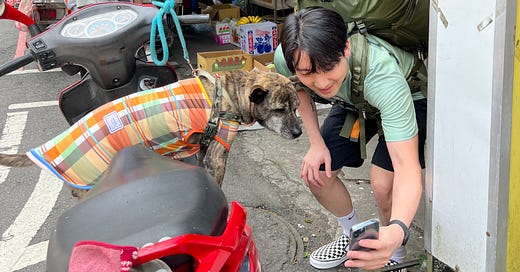안녕하세요! Hello everyone!
First of all, I would like to say I’m truly sorry for being absent for such a long time. As some of you guys already know, I went to Taiwan for 2 weeks earlier this month and I had an amazing time travelling the country😄 But unfortunately, I got sick when I came back home in Canada which forced my vacation to be extended and, I’m not going to lie, it also made me extremely lazy😅
Before diving into today’s content, let me show you a few pictures from my trip!
I got to use my Chinese every day so I really liked that, because I don’t have many chances to use the language at all these days. And I feel like I’ve become quite an expert about Taiwan, so if you ever plan to visit the country, feel free to ask me questions!
Do you have any plans to travel? Maybe going to Korea? Let me know where you are going or you wish to go in the comments!
Also, I’m starting my next cohort for Korean 101: Hangul Crash Course next Thursday, June 8th! So if you are interested in joining, don’t hesitate to reach out or directly sign up by clicking the button below!😄
Alright! Now back to our lesson, since it’s been a while we learned something together, I’m going to take it easy today. As a matter of fact, I was thinking of starting from the absolute beginning of the Korean language: Hangul or the Korean writing system. I’ve already talked about the history behind it in terms of how Korean writing system came to exist, so we will dive right into the Korean letters!
As you should already know, the Korean language has both consonants and vowels just like English and many other languages. Today, we are going to talk about the consonants.
Before we take a look at the Korean letters, though, let’s have a look at the English alphabet. The important thing here is to focus on the sounds the English letters make and associate them with the Korean letters. Below, we have the English alphabet from A to Z.
A B C D E F G H I J K L M N O P Q R S T U V W X Y Z
Let’s cross out the vowels since we are only looking at the consonants today.
A B C D E F G H I J K L M N O P Q R S T U V W X Y Z
Next, I’m going to explain the sounds that exist in English but don’t exist in Korean. As a matter of fact, there are no F, V and Z sounds in Korean. This is why when Korean people say English words that have these sounds, it sounds very funny. For example,
F ➝ P
Fail = 패일 [pe-il]
Friend = 프렌드 [peu-ren-deu]V ➝ B
Vacation = 배케이션 [be-ke-i-shyeon]
Vaccine = 백신 [bek-shin]Z ➝ J
Pizza = 피자 [pi-ja]
Zebra = 지브라 [ji-beu-ra]
As you can see, F is substituted with P, V with B, and Z with J in Korean. Though, we need to note that these sounds are not always written with the substitutes I just mentioned. I’m sure you’ve heard of this iconic Korean phrase “Fighting!” which has nothing to do with the word ‘fight’, but people say this to encourage and cheer someone up. Interestingly, this phrase is usually not said with the Korean letter P, but with the letter H instead. So, the pronunciation is [hwa-i-ting], instead of [pa-i-ting].
So, let’s get rid of these 3 consonants!
A B C D E F G H I J K L M N O P Q R S T U V W X Y Z
The sounds of the remaining consonants can be made with the Korean alphabet. However, the following consonants—W, X, and Y—cannot be substituted with a single Korean consonant to make the same sound. Instead, the sounds these consonants make can be created by combining a consonant and a vowel. We will take a look at example words in future lessons.
So, let’s cross these 3 consonants off from the list since there are no direct equivalents!
A B C D E F G H I J K L M N O P Q R S T U V W X Y Z
So how many consonants do we have left?
15 consonants! Will that be the number of consonants in Korean?
No😅
There are a few more points to know.
Among the remaining consonants, we can see that the letter C, K and Q produce the same [k] sound like coat, key and quick to name a few.
➝ After grouping these three consonants, we have 13 consonants left.In the Korean writing system, the letter R and L is written with just one single consonant. I’ll talk more about this in a future lesson. But, we will go ahead and group these two as one consonant.
➝ After grouping these two consonants, we have 12 consonants left.We’ve been either removing consonants or grouping a few consonants into a single consonant, but there are also a couple of Korean consonants that the English alphabet doesn’t have.
A placeholder consonant: this consonant will be discussed entirely on its own in a future lesson
The [ch] consonant: the sound of two consonants put together, ch, can be written with a single consonant in Korean.
➝ After adding these two consonants, we have 14 consonants.
G: ㄱ
N: ㄴ
D: ㄷ
R/L: ㄹ
M: ㅁ
B: ㅂ
S: ㅅ
Placeholder: ㅇ
J: ㅈ
Ch: ㅊ
K: ㅋ
T: ㅌ
P: ㅍ
H: ㅎ
And these consonants make up the total number of consonants in the Korean writing system.
If you remember what we learned in a previous lesson, we know that the 14 consonants can be divided into 5 different groups depending on where the sounds are made in the mouth:
Velars: sounds made around the uvula
ㄱ, ㅋ
Alveolars: sounds made from just behind the front teeth where there is a ‘bump’
ㄴ, ㄷ, ㅌ, ㄹ
Bilabials: sounds made around lips
ㅁ, ㅂ, ㅍ
Dentals: sounds made around teeth
ㅅ, ㅈ, ㅊ
Glottals: sound made around vocal cords
ㅇ, ㅎ
Only the bold letters make up the 14 consonants and they are called ‘basic consonants’. We will take a look at each consonant in the next lesson and learn how to effectively memorize them!
I’ll be sending you lessons a little more often than before and I hope you can keep up the good work! Have a good rest of the week!
다음에 또 봐!💙







After a long. Waiting. 💜💜❤️❤️❤️❤️🥰🥰 So happy you are feeling better. I really missed your newsletter !
Looks like you had an awesome time in Taiwan. Hopefully you are feeling a lot better now. I would love to travel but i'm a bit afraid of flying. My sister already has plans for us to go on a cruise next year and plans for Korea at some point. I just have to get pass flying. Anyway, thanks for sharing your e-book. It should help.